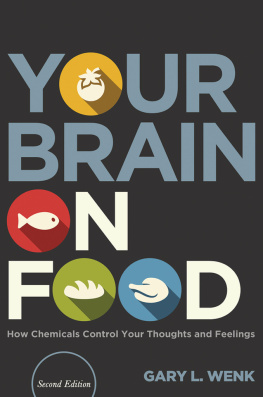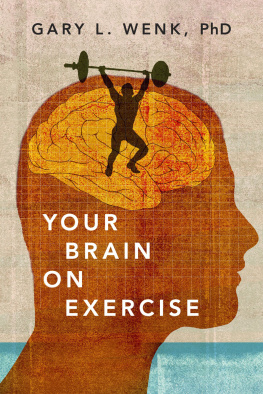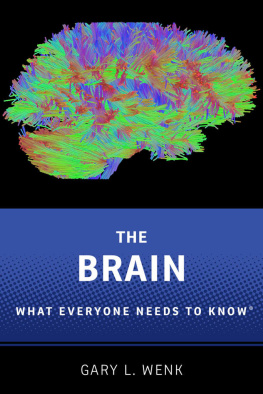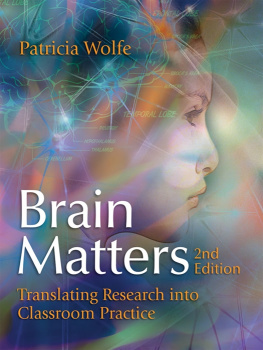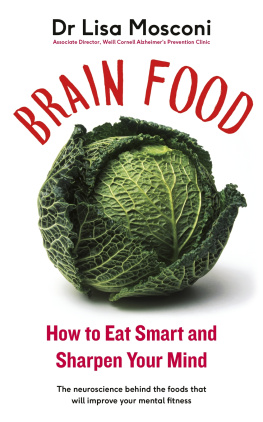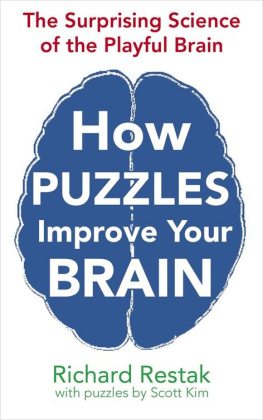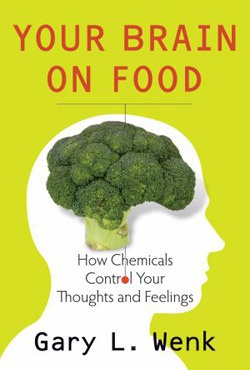YOUR BRAIN ON FOOD


Oxford University Press is a department of the University of Oxford.
It furthers the Universitys objective of excellence in research, scholarship, and education by publishing worldwide.
OxfordNew York
AucklandCape TownDar es SalaamHong KongKarachi
Kuala LumpurMadridMelbourneMexico CityNairobi
New DelhiShanghaiTaipeiToronto
With offices in
ArgentinaAustriaBrazilChileCzech RepublicFranceGreece
GuatemalaHungaryItalyJapanPolandPortugalSingapore
South KoreaSwitzerlandThailandTurkeyUkraineVietnam
Oxford is a registered trademark of Oxford University Press in the UK and certain other countries.
Published in the United States of America by
Oxford University Press
198 Madison Avenue, New York, NY 10016
Oxford University Press 2010, 2015
All rights reserved. No part of this publication may be reproduced, stored in a retrieval system, or transmitted, in any form or by any means, without the prior permission in writing of Oxford University Press, or as expressly permitted by law, by license, or under terms agreed with the appropriate reproduction rights organization. Inquiries concerning reproduction outside the scope of the above should be sent to the Rights Department, Oxford University Press, at the address above.
You must not circulate this work in any other form and you must impose this same condition on any acquirer.
Library of Congress Cataloging-in-Publication Data
Wenk, Gary Lee, author.Your brain on food : how chemicals control your thoughts and feelings / Gary L. Wenk.
Second edition.
p. ; cm.
Includes bibliographical references and index.
ISBN 9780199393275
eISBN 9780199393299
I. Title.
[DNLM:1. Brainphysiology.2. Emotions.
3. Neurotransmitter Agentsphysiology.WL 300]
RM315
615.78dc23
2014014927
for Jane
CONTENTS


Various writers over the past century have compared the human brain to an elegant machine. Imagine that this machine is full of wires and that the wires are different-colored. Some are blue, some are red, some are green, and so on, but they all convey information from one part of the machine to another. Now imagine that the blue wires are organized differently than the red wires, that the red wires are organized differently than the green wires, and so on. If you were to look inside your brain, you would discover that although its pathways are organized like the colored wires in your telephone or computer, it doesnt actually use wires at all but instead uses cells, or neurons, to process information: One neuron is connected to the next and to the next, and so on. Indeed, this elegant machine, your brain, is composed of approximately 100 billion neurons, and within a single structure, the cortex, these neurons make an estimated 0.15 quadrillion connections with each other. These billions of neurons are not uniquely colored, but they do release unique chemicals, called neurotransmitters, onto each other. What happens when molecules of a foreign substancesay, a drug or a morsel of foodinteract with the balance of neurotransmitters in this chemical soup? The balance of flavors in this soup will determine what happens to you.
The major point that I want to make in this book is that anything you consumethe drugs you take, the foods you eatcan affect how your neurons behave and, subsequently, how you think and feel. In the course of illustrating this point, I examine what neuroscientists currently know about the actions of specific drugs and food in the brain and seek to advance your understanding of your own brain by demonstrating how its workings can be altered by what you feed it. So Ill be describing several neurotransmitter systems, including a little about their basic role in the brain, and explore how various substancesbe they plant extracts, nuts, mushrooms, spices, chocolate, or medicinal and recreational drugscan influence these neurotransmitters in terms of their production, their release from the neuron, and their ultimate inactivation and excretion from the body. I also discuss the brains role in certain experiencesfor example, hallucinations, religiosity, pain, and the aging processand the extent to which these experiences are influenced by what we consume. In addition, I consider the role of evolution in determining the brains responses to the food and drugs that we consume and place the use of some of these substances in cultural history.
The brain contains over 100 known, or suspected, neurotransmitter chemicals and probably many more that scientists have yet to discover. I have chosen to focus on those neurotransmitter systems most commonly associated with the psychoactive effects of drugs and nutrients that, in many cases, are regularly consumed today.
In essence, this book is intended not as an exhaustive review of all that is known about the topic of food and drugs and the brain but as a briefand, I hope, enjoyableintroduction to it. By the end of the book, you will know more than just how a select group of drugs or food works in your brain, you will be able to predict how substances that I did not discuss, and those that have not even been discovered yet, might also affect your brain. Even better, you may look back on the chapters youve read and discover that they are much too simplistic for you now and that you want to learn more about greater complexities of brain function than this book covers. If reading this book motivates you to learn more about neuroscience and its associated topics, then I will have succeeded in my goal to advance your understanding of your brain. The suggested readings that Ive listed at the end of the book offer an excellent next step in that advancement.
This book could not have been written without the encouragement and generosity of my mentors, colleagues, family, and friendsparticularly David Olton, who patiently motivated my curiosity in the effects of drugs on the brain; James McGaugh, who inspired my interest in behavioral pharmacology; Giancarlo Pepeu, who has continued to nurture my interest in the role of drugs in the history of culture; Peabo Bryson, who challenged me to explore the role of neuroscience in religion; Paul Gold, for the many thought- provoking discussions on the Utah slopes; and Jacqueline Crawley, for her boundless enthusiasm and stimulating insights into the function of the brain. Their wisdom helped focus my fanciful ideas into rational theories. I will always be grateful to Catharine Carlin at Oxford University Press for her unflagging support and optimism at the beginning of this long journey. I also feel very privileged to have worked with Marion Osmun and Joan Bossert, my editors, who provided a nurturing combination of advice and encouragement. I am also grateful to the thousands of students who have taken my psychopharmacology classes and whose personal stories enliven these pages. Finally, for more than 30 years, I have been blessed to share my life with a woman of unrivaled intelligence and uncommon patience. Her profound personal wisdom has enriched my life in countless ways. This book is dedicated to Jane.

